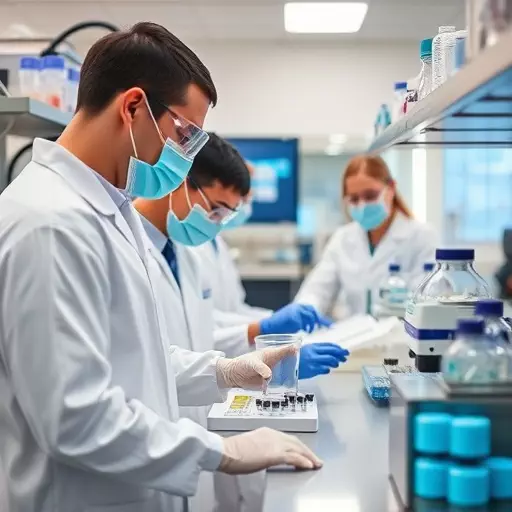In Grand Rapids-Kentwood-Muskegon's dynamic lab landscape, optimizing staffing and implementing automated sample handling systems are key to achieving peak efficiency. Traditional manual methods struggle with the demands of large, multi-site labs. Automation streamlines processes, reduces errors, and enhances resource allocation, enabling better data integrity, security, and consistency. By selecting suitable automation technologies (e.g., robotic arms, conveyer belts), labs can optimize staffing, manage compliance across sites, and ensure consistent quality in a competitive, regulated environment. Continuous monitoring and data analysis post-automation are crucial for dynamic efficiency and adherence to regulatory standards.
In the dynamic landscape of lab work in Grand Rapids-Kentwood-Muskegon, automation is transforming how research and development occur. This article offers comprehensive guidelines for implementing automated sample handling systems, a game-changer for optimizing lab staffing and enhancing efficiency. From understanding the pressing need for automation to navigating compliance challenges in multi-site laboratory networks, we delve into strategies that ensure peak performance. Learn how to select the right technology, implement seamless integration, and continuously monitor improvements post-automation rollout, all while managing compliance effectively across diverse sites.
- Understanding the Need for Automated Sample Handling in Lab Work Grand Rapids-Kentwood-Muskegon
- Optimizing Lab Staffing: Strategies for Peak Efficiency
- Navigating Compliance Challenges in Multi-Site Laboratory Networks
- Selecting the Right Automation Technology for Your Labs
- Implementing and Integrating Automated Sample Handling Systems
- Continuous Monitoring and Improvement Post-Automation Rollout
Understanding the Need for Automated Sample Handling in Lab Work Grand Rapids-Kentwood-Muskegon

In the bustling landscape of lab work in Grand Rapids-Kentwood-Muskegon, where precision and efficiency are paramount, the need for automated sample handling systems has become increasingly evident. Traditional manual methods, while reliable, often fall short in terms of productivity and accuracy, especially in multi-site laboratory networks. Optimizing lab staffing to achieve peak efficiency is a complex task, as it involves not just hiring but also training staff, managing schedules, and ensuring adequate coverage during peak hours.
Moreover, navigating the intricate web of compliance regulations across different sites can be challenging. Managing samples from various locations requires stringent protocols to maintain data integrity, security, and consistency. Automated systems offer a promising solution by streamlining sample processing, reducing human errors, and enabling better resource allocation. By implementing these technologies, laboratories in Grand Rapids-Kentwood-Muskegon can enhance their operational capabilities, meet compliance standards more effectively, and ultimately improve the overall quality of lab work.
Optimizing Lab Staffing: Strategies for Peak Efficiency

In the dynamic landscape of lab work in Grand Rapids-Kentwood-Muskegon, optimizing staffing levels is a strategic imperative for maintaining peak efficiency and productivity. This involves a nuanced approach that goes beyond simply hiring more staff. Effective strategies include leveraging automation technologies to handle repetitive tasks, thereby freeing up personnel to focus on complex analyses and technical expertise. Additionally, implementing flexible scheduling models allows labs to adapt to fluctuating work demands, ensuring adequate coverage during peak periods while avoiding overspending on staffing during slower times.
Managing compliance in multi-site laboratory networks further complicates the staffing equation. To navigate this challenge, laboratories must adopt standardized procedures and comprehensive training programs that ensure consistent quality across all sites. Centralized management of staff schedules and task allocation can facilitate equitable workload distribution and maintain regulatory compliance. By fostering a culture of continuous improvement and leveraging data analytics to identify bottlenecks, labs can continually refine their staffing strategies, ensuring they remain agile, efficient, and compliant in the ever-evolving landscape of scientific research and testing.
Navigating Compliance Challenges in Multi-Site Laboratory Networks

In the dynamic landscape of lab work in Grand Rapids-Kentwood-Muskegon, implementing automated sample handling systems can significantly enhance efficiency and accuracy. However, navigating compliance challenges within multi-site laboratory networks is paramount to ensure consistent quality and regulatory adherence. As these networks span multiple locations, managing compliance becomes intricate due to varying local regulations and internal protocols. To optimize lab staffing for peak efficiency, laboratories must devise strategies that harmonize standard operating procedures across sites while allowing for flexible adaptations to specific regional requirements.
How to achieve this balancing act? Implementing robust communication channels and centralized training programs can foster a uniform understanding of compliance standards. Utilizing advanced technology platforms facilitates real-time data sharing and quality control measures, ensuring consistent protocol execution. Moreover, regular audits and performance monitoring across all sites strengthen compliance management by identifying areas for improvement and fostering continuous enhancement in managing compliance in multi-site laboratory networks.
Selecting the Right Automation Technology for Your Labs

When implementing automated sample handling systems in Grand Rapids-Kentwood-Muskegon labs, choosing the right automation technology is paramount to achieving peak efficiency and optimizing lab staffing. Consider the unique needs of your lab work—from high-throughput processing to specialized sample types—when selecting a system. Advanced robotic arms, conveyer belt systems, and automated storage and retrieval robots offer versatile solutions for managing compliance in multi-site laboratory networks. These technologies streamline workflows, reduce manual errors, and ensure consistent quality control across locations.
Understanding your lab’s specific requirements is crucial to making an informed decision. Assess factors like sample volume, processing speed needs, and the need for integration with existing systems. For instance, if your labs handle a large number of samples daily, robotic arms might be more efficient than conveyer belts. Optimizing staffing becomes easier when automation handles repetitive tasks, freeing up technicians to focus on complex procedures and analysis. This approach can lead to improved productivity and better resource allocation in Grand Rapids-Kentwood-Muskegon laboratory settings.
Implementing and Integrating Automated Sample Handling Systems

Implementing and integrating automated sample handling systems can significantly transform lab work in Grand Rapids-Kentwood-Muskegon, enhancing efficiency and accuracy. These advanced technologies streamline processes like specimen collection, labeling, storage, and distribution, reducing manual effort and potential errors. To optimize lab staffing for peak efficiency, laboratories should consider the volume of samples, turnover rates, and critical timelines when implementing these systems. For instance, high-throughput labs may require more sophisticated automation to keep up with demand, while smaller facilities might opt for simpler, customizable solutions tailored to their specific needs.
Managing compliance in multi-site laboratory networks is another crucial aspect. Automated systems must adhere to regulatory standards such as GLP (Good Laboratory Practice) and ensure data integrity across all locations. Integrating these systems into existing workflows requires careful planning and coordination to maintain consistency in procedures, documentation, and quality control measures. By aligning with industry best practices, laboratories can leverage the benefits of automation while ensuring compliance, ultimately improving productivity and service delivery in Grand Rapids-Kentwood-Muskegon and beyond.
Continuous Monitoring and Improvement Post-Automation Rollout

After implementing automated sample handling systems in laboratories across Grand Rapids-Kentwood-Muskegon and beyond, continuous monitoring is key to success. Regularly assessing performance metrics allows labs to identify bottlenecks or areas for improvement, ensuring optimal efficiency throughout the entire process. By analyzing data on processing times, error rates, and operator workload, lab managers can make informed decisions to further optimize staffing levels and shift workflows as needed. This ongoing refinement process helps maintain peak efficiency as lab work demands change over time.
Maintaining compliance across multi-site laboratory networks is another critical aspect of post-automation management. With automated systems in place, centralized quality assurance teams must ensure standardized procedures are consistently applied at each location. Regular audits and training sessions help keep all sites aligned with regulatory requirements and industry best practices. This collaborative approach to managing compliance fosters a culture of quality across the network, ensuring consistent results from lab work regardless of its geographic location.
